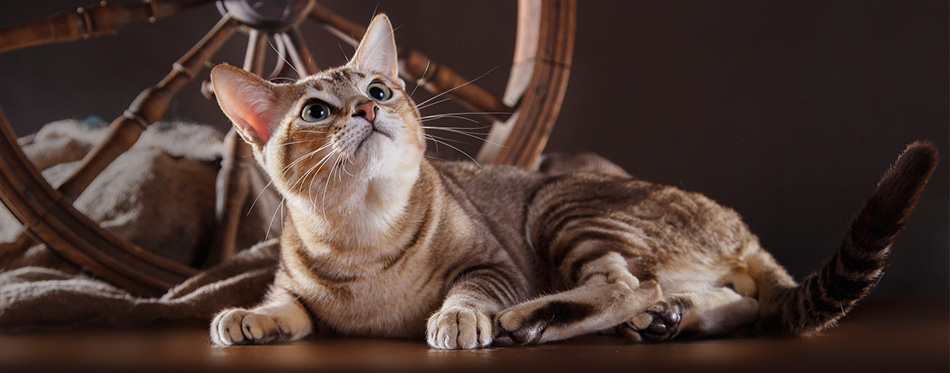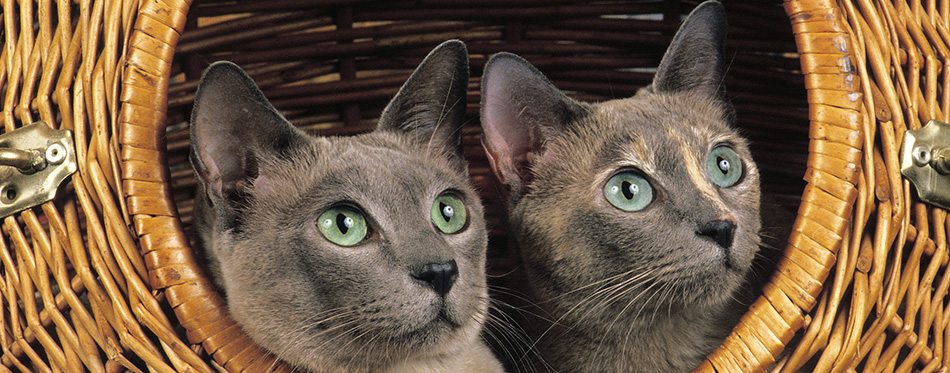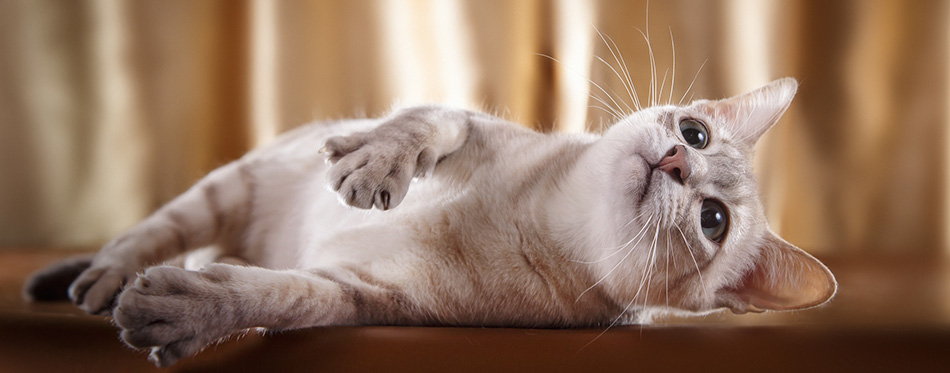The mischievous and totally adorable Tonkinese is a crossbreed with Burmese and Siamese ancestors. It is a relatively new breed and there has been controversy about whether it should be allowed to compete in cat exhibitions. Nevertheless, as a pet, the Tonkinese has many outstanding qualities and will bring love and fun into your home.
They have a medium build but are very muscular so you may be surprised by how much they weigh. They have a relatively long life expectancy and can live to over 18 years; they enjoy good health and are generally very robust. This breed is most suited to living indoors and is not well equipped to cope with the rigors of life outside the home.
Their short coat requires little maintenance and can be a variety of colors. A distinguishing feature is their aqua colored eyes which reflect differently depending on the light and time of day. If you are looking for a cute cat clown who will adore you, this is the breed for you.

History of the Tonkinese
You may not think that a cat breed could be controversial but a quick look at the history of the Tonkinese proves that it can! Whilst this lovely breed has probably been around for centuries, it is only in the last few decades that conscious efforts have been made to successfully breed it.
The Tonkinese is the product of crossing a Burmese with a Siamese and the first of their kind arrived in Western countries as imports from Thailand; they had solid brown coats. Offspring from these early arrivals would become Burmese, Havana Browns and chocolate point Siamese as well as Tonkinese. To begin with, Siamese and solid-colored cats were allowed to be exhibited but in the early 1900s, Siamese cats that did not have blue eyes were banned from competing.
By the early 1960s, a clever Canadian breeder called Margaret Conroy, was able to cross sable Burmese with seal point Siamese and produced golden Siamese offspring. Several breeders were able to achieve consistency within the breed in terms of head and body shape and named the new breed Tonkinese after the Bay of Tonkin in North Vietnam.
The Tonkinese therefore has the honor of being the first cat breed ever developed in Canada. Conroy collaborated with other Canadian breeders to compose the first ever standard for the breed and present it to the Canadian Cat Association (CCA). It was recognized by the Cat Fanciers’ Foundation (CFA) 1974 and by the International Cat Association 1979. However, there was and still is a lot of opposition to the Tonkinese being recognized as a breed. Many experts feel that they are only suitable as pets and should not be exhibited at shows as a purebred because it is such a recent line of breeding.
Quick Facts About the Tonkinese
- Their coat does not mature for two years
The Tonkinese have three possible coat patterns which are solid, pointed, and mink which is a combination of the two. However, you will not know what your Tonki will look like until they are two years old because it takes this long for their mature coat to develop.
- They have only recently been awarded Pure Breed status
Although the Tonkinese were bred for the first time in the 1960s, they were not awarded Pure breed status until 2001. Prior to this, they were classed as a Cross breed. There remains considerable controversy about their status and some experts still think that they should not be allowed to be exhibited in competitions.
- They are named after an area that has nothing to do with them!
Some people assume that the breed originated in the Indochina region called Tonkin but that is not actually the case. They have no connection with this area and were first bred in Canada.
- They weigh more than you expect
The Tonkinese is not a very large breed, they would be classed as a medium-sized cat. However, when you pick one up, you may be surprised by how much they weigh. This is because they have a muscular build that weighs more than you would expect. Their build is halfway between the lean Siamese and the stockier Burmese breed. A Tonkinese will weigh between six and 12 pounds.
- Your Tonk will make you laugh
When you live with a Tonk, there will never be a dull moment. They are highly intelligent cats and are very outgoing. They may love to ride on your shoulders or they may just follow you around the house. Whatever you are doing, they will want to be a part of it.
- They love to be up high
If your Tonk ever goes missing, try searching at the top of your closet or above your kitchen cupboards. This is where they are most likely to be! The breed loves to jump up on high surfaces and look down on the world below them. For a wider selection of choices, check out our cat window perches guide.
- Tonkinese kittens are hard to find
The Tonkinese is not a common breed so if you have set your heart on having a Tonkinese kitten, you will have to do some research and you may have to wait a while.
You will not find one in your local rescue shelter or group. The best approach is to find a reputable Tonkinese breeder and wait for their breeding cats to produce a kitten for you!

Things You Should Know About the Tonkinese
The Tonkinese is a funny, friendly and very smart medium-sized cat who will fill your home with love and be your devoted companion. You can expect your Tonk to live a long and happy life with very few health problems. However, it is vital that you do your research before you invite one to come and live in your home to make sure that you know how to keep them happy and healthy. Here’s a quick summary of what you need to know.
Health
The Tonkinese are one of the hardiest breeds and enjoy a long life expectancy of 15-18 years.
They can get gingivitis, which is gum disease, and this can result in a lot of pain and discomfort and even loss of teeth if you are not vigilant. If you notice that your Tonk is showing signs of dental discomfort, take them to your vet for a checkup. It has also been noted the Tonkinese breed can be sensitive to anesthesia. If your cat is booked in for surgery, make sure that you discuss this potential problem with your vet. It may be wise to find a vet who has operated on Tonkinese cats before and understands the risks and how to minimize them.
You need to bear in mind that the Tonkinese are descended from the Siamese breed and are therefore prone to developing some of the same disorders.
You may want to be alert for the signs of inflammatory bowel disease (IBD) which include vomiting, weight loss, diarrhea with blood in the poop, lethargy and a loss of appetite. The symptoms are very variable. They can also suffer from excessive protein deposits which is called amyloidosis. This is common amongst their Siamese ancestors. The protein builds up in the liver and can eventually lead to fatal liver failure. The cat can become dehydrated, their coat will look poor, they will be drinking a lot and peeing a lot and may lose weight. Eventually, the liver can rupture and the cat will need emergency treatment. This condition develops between one and five years of age.
Tonkinese kittens are also prone to respiratory infections. Most of these are caused by viruses called Feline calicivirus or feline herpesvirus. It occurs most often in shelters and in houses where several cats are living. The viruses are transmitted from one cat to another by sneezing, coughing and sharing food and water bowls.
Feeding
Your Tonkinese will not need a special diet and any premium cat food is likely to suit them. If you are not sure what to feed them, seek advice from an experienced breeder or from your vet.
All cats need a diet that is rich in protein derived from animal sources. They cannot digest plant proteins so well and cannot live on a vegetarian diet. A recipe that contains high quality meat ingredients such as chicken meat or fish is ideal. Many cats do well on dried food but they must have plenty of fresh water to prevent dehydration. If you suspect that your cat is not getting enough fluids, you may want to opt for wet food instead. Tonkinese are not usually fussy eaters.
When you first get your kitten back home, stick with the food that they were eating at the breeders. Then, transition them very gradually to another food. You do this by removing a very small portion of their original food and replacing it with the new food. Over a period of a few weeks, gradually increase the proportion of the new food and decrease the proportion of the old food until they are entirely on the new food. If you notice any adverse reactions such as diarrhea or skin irritation, you may need to return to the old food.
If your Tonk lives entirely indoors, they may not need so many calories and could be in danger of putting on too much weight. The Tonkinese is a heavy cat but their weight should be made up of muscle and not fat. Keep an eye on their weight because obesity is a serious health issue for cats and can result in many health problems. Your vet can give you further advice on how to control your cat’s weight. Remember that treats need to be included when you are calculating your cat’s overall daily calorie intake.
For more guides on choosing the right cat food, you may wish to check out our reviews of the best wet cat food, senior cat food, hypoallergenic cat food, cat food for hairballs and cat food for sensitive stomachs.
Care
Your Tonk will be a low-maintenance pet and will require very little in the way of special care. You will need to keep an eye on their claws and provide a scratching pad if they are not allowed outside. This will help to keep their nails in check but they are still likely to need a regular trim. For this, you will need special pet nail clippers and some patience. The guillotine style pet claw trimmers are a good option for cat owners and are easy to use because they do not slide along the shaft of the nail. Get your cat used to having their nails clipped when they are a kitten to avoid problems when they are an adult.
You will also need to be vigilant for dental problems and gingivitis is the most common condition that you should be aware of. It causes damage to the gums and can lead to a loss of teeth and a lot of discomfort for your cat. You can help to stop gingivitis from setting in by brushing your cat’s teeth regularly. You will need to use a toothpaste produced just for cats (never use human toothpaste) and it is necessary to begin regular toothbrushing when they are a kitten. It would also be useful to invest in a special cat toothbrush.

Grooming
The short, neat coat of the Tonkinese is not difficult to care for and is something that even inexperienced cat owners will be able to cope with. All you need to do is give them a good brush with a suitable rubber cat brush or comb one a week or so. This will remove any dead hairs (and prevent them from shedding on your furniture) and distribute the natural oils around the coat. This provides moisture and protection for each hair.
Some owners like to occasionally bath their cat, especially if they are allowed to go outside and get dirty. If this is something that you intend to do, it is vital that you start when they are a kitten. It is unlikely that an adult cat that has never been bathed will take very well to it! However, if you Tonk is happy to have the occasional bath, it will certainly help to keep their mink-like coat in tip-top condition.
Use a special cat shampoo and make sure that they are thoroughly dried afterwards so that they do not get cold.
For more help on cat grooming, you may wish to read our guides on the best cat ear cleaners, cat nail clippers, brushes for cats, cat grooming gloves and cat shampoos.
Temperament
Human company is very important to the Tonkinese so bear this in mind before you invite one to live in your home. If you prefer your cats to be aloof and independent then the Tonkinese is probably not the best breed for you.
They do not like to be alone. Therefore, if everyone in your household is out at work and school during the day, it would be sensible to get two cats or a cat and an easy-going dog who can keep each other company.
When you are at home, you will find that your Tonk is highly affectionate and will like nothing better than curling up on your lap and having cuddles. They will have no problems getting on with children of all ages but it is always sensible to supervise very young children when they are with pets of any kind. You will find that your Tonk is quite vocal and you could end up having some interesting conversations although they are not quite as chatty as the Siamese.
One particular trait that you may find amusing is the Tonk’s love of high places. You are likely to find them on top of your closet when you come in and they will love to ride around the house on your shoulders.
Tonks like to play so invest is some games that you can enjoy together. They will retrieve toys that you throw and enjoy a wide variety of interactive activities. You can even teach your Tonk to walk on a leash and harness with little difficulty. This highly intelligent breed has a long memory and is certainly clever enough to be trained to fetch toys but because they also have a strong will, you will need to be patient and consistent with your training. Check out our guide on the best harness for cats for more info.
This breed has a very trusting nature and does not have some of the defensive skills that other more ‘street-wise’ cats have. For this reason, it would be safer if they are kept indoors where they will be safer and not so vulnerable to accidents and attacks.
When you have visitors, your Tonk will assume that it is their job to entertain them They are the natural clowns of the cat world and will soon have everyone laughing at their mischievous ways. They do not tend to have favorite humans, they will work their way around the room making sure that everyone has the opportunity to stroke and cuddle them.

The Last Word
This gregarious and loving breed make superb pets. They will get on with all the humans and other pets in your household and keep you all entertained. They adore games with their human companions but are equally happy with a cuddle. Life is never dull with a Tonkinese who will spend quite a lot of time on top of your furniture or on your shoulders!
Source:
- About the Tonkinese – CFA

